The 9.7" iPad Pro Review
by Brandon Chester on June 1, 2016 9:00 AM ESTBattery Life
Apple has always advertised the iPad as achieving all day battery life. I've generally found that to be true based on my usage, although on days where I use the larger iPad Pro with the Apple Pencil heavily I can find myself looking for a charger by the time the work day is over. With our 2016 mobile test suite we've rolled out a new WiFi web browsing test that is more taxing on devices than the previous one, along with moving from GFXBench's T-Rex HD battery test to Manhattan Metal. With the 9.7" iPad Pro having a similar battery capacity to the iPad Air 2 it can hopefully be expected that battery life remains the same, or possibly improves.
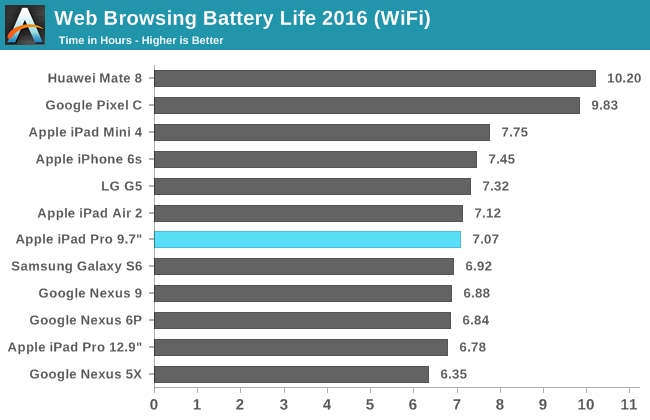
In our 2016 WiFi web browsing test the 9.7" iPad Pro comes in at roughly the same runtime as the iPad Air 2. Apple has always advertised a ten hour battery life for iPads, and that generally held true in our old test which did static page loads. But in our new test the iPads simply can't last that long due to the heavier and more representative workload.
Unfortunately I no longer have the Tab S2 for comparisons to a non-Google Android tablet in this test, but when it comes to battery life the 9.7" iPad Pro lasts a bit longer than the Nexus 9 and significantly shorter than Google's Pixel C. The Pixel C is also significantly thicker and heavier, but its LTPS display also helps it to drive down platform power, and I wouldn't expect to see the iPads approach it any time soon with Apple's continued focus on driving down mass and thickness, and reliance on IGZO displays to achieve their switching refresh rate.
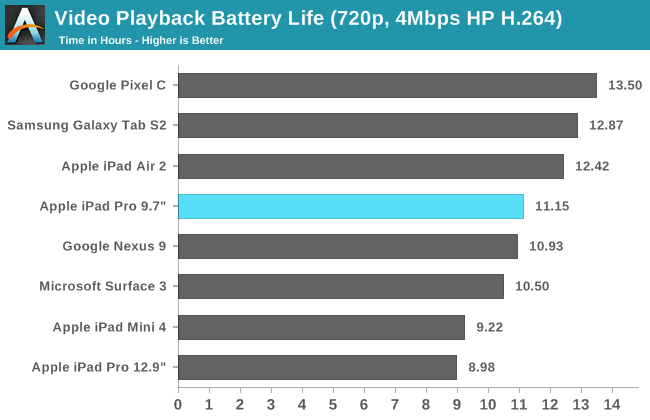
The 9.7" iPad Pro does well in our video playback test. This test hasn't changed from the 2014 one, as my measurements found that the impact of moving to higher resolution and higher bitrate test files has a negligible impact on battery life due to the fact that the decoding for H.264 is all handled by dedicated hardware. You can see that the Pixel C still leads the pack, and the Tab S2 is close behind it even though it's incredibly thin and has a relatively small battery, and this is due to its AMOLED display using much less power in low APL videos than your typical IPS LCD on a tablet.
It's worth noting that we see a regression here from the iPad Air 2. The 9.7" iPad Pro actually has a slightly larger battery than the iPad Air 2, and I'm not sure where the difference here is coming from (possibly the display?), as our video playback test is conducted in airplane mode with no background tasks or location services, so there's not much room for software variance.
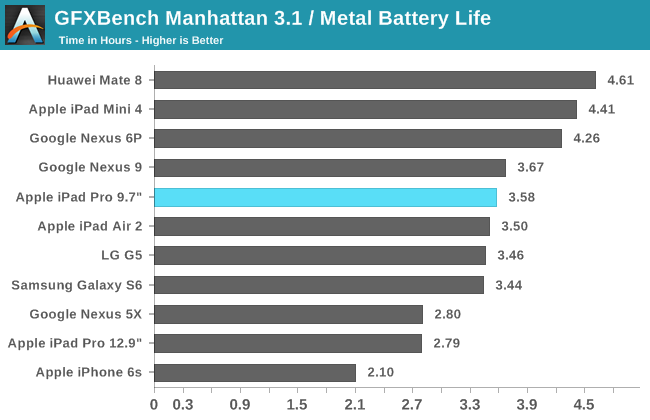
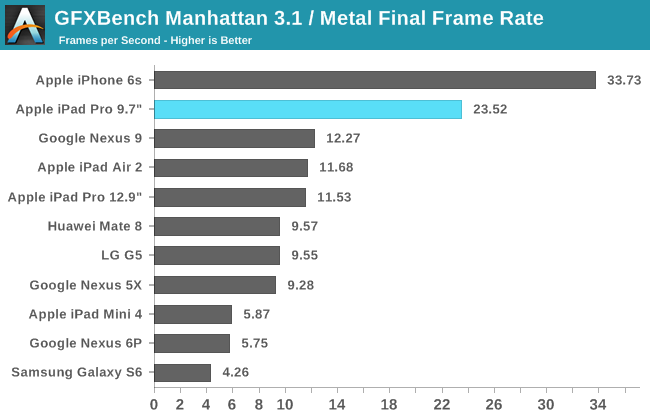
In the GFXBench 3.1 Manhattan battery test the 9.7" iPad Pro performs incredibly well. Not only does it last slightly longer than the iPad Air 2, but the GPU performance throughout the test is more than double that of the A8X. With our old T-Rex HD test we saw Apple's devices essentially maintain the same frame rate for the entire test, as the GPUs were so fast that they were actually spending time idling. With Manhattan this isn't the case, and we see that the 9.7" iPad Pro does show signs of throttling. In general the performance is still very stable, and the throttling is not near as serious as what I've seen on competing Android tablets running the old T-Rex test with its lighter workload.
Charge Time
Smartphones have gone from taking several hours to charge a few years ago to only taking an hour or two today. Unfortunately we haven't see such improvements with tablets. While charge times have certainly gone down with Apple's 9.7" iPads, that's due to shrinking batteries rather than significantly faster charging. With the 12.9" iPad Pro Josh measured a charge time of over five hours, which is really unacceptable to say the least. With the 9.7" iPad Pro using a battery of similar size to the iPad Air 2, it can hopefully be expected that the charge time will be similar too.

Apple includes a 10W brick with the 9.7" iPad Pro. I actually haven't kept track of when they switch between 10W and 12W, but I can tell you that they need to start shipping these tablets with something closer to 20W or 30W. They happen to already sell something that fits the bill quite nicely, and customers would appreciate it. In the case of the 9.7" iPad Pro the charge time is much shorter than the five hours that the 12.9" model takes, but I think we really need to see improvements in how long it takes to charge these devices. When you use an iPad all the time for writing with Apple Pencil it will most certainly be nearly dead when you get home, and that means you can't use it for the rest of the night unless you keep tethered to a power outlet. Hopefully we see improvements made here with the next generation of iPads, along with the rest of the tablet market in general.


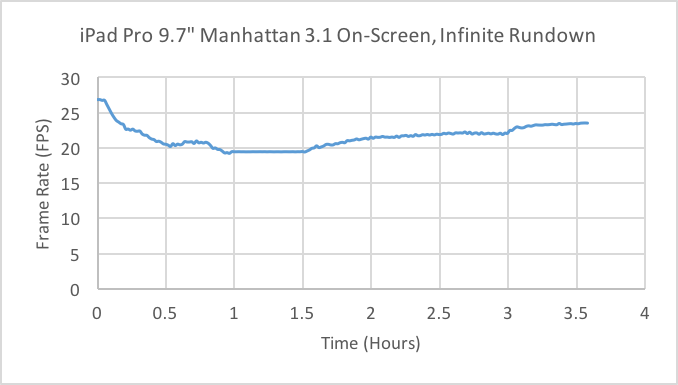








144 Comments
View All Comments
digiguy - Friday, June 3, 2016 - link
What do you know? even core I7 has been made fanless in a 12 inch tablet with a new cooling solution, so I don't see why core M could not work well in 10 inches. Battery life will depend on the battery size, in the onda it's smaller than in ipad air 2 for instance, and it lasts around 4 hours, with a bigger one it could last more, but is definitely much more than the 1 hour you speculate about...erple2 - Sunday, June 5, 2016 - link
But then that's the point, isn't it? Throwing a honestly poorly designed 10" tablet as proof that you can get a good tavlet with Core M is not helping your argument. How good is the display? How are the touch apps? How well does the pen work? How heavy is it? How hot does it run? How long does it run on a charge? What about everything else that is tested? Honestly, there has to be a reason why the big players hasn't integrated a more powerful CPU into a small tablet.As a staunchly anti Apple person, I gave to co cede that Apple really does have the best tablet this generation. While the Pixel C comes close, the Pen is very well implemented. Surfaces are fine, but I find that when I want to do real work, I turn to my much more powerful laptop to do that.
melgross - Wednesday, June 1, 2016 - link
Neither Surface Pro display can match the display for this product. First of all those products were reviewed before this one came out, and secondly, they are both sRGB displays, with their resultant smaller color gamut.Also, the iPad Pro, either model beats the least expensive Surface Pro in performance, and that model costs as much, or more than the competing iPad.
I understand that your Microsoft products are second best in a number of ways. Get used to it.
jlabelle2 - Thursday, June 2, 2016 - link
Having a wider color gamut than sRGB is not universally an advantage. Without going into this discussion on how many (little) images are benefiting from that, even in a proper color managed workflow (and iOS seems to be quite good here), sharing and distributing images with wider color space than sRGB is often (most of the time) counterproductive if others 1/ do not have wide gamut screen (the majority), 2/ do not have applications / browser reading the embedded color space (the majority). As such, the interest is honestly quite limited. It does not hurt at all the iPad, on the contrary, but in real life this is not what will make such display stands above other sRGB gamut wide screens.And regarding the Surfaces and DisplayMate, read in details and you will see they are also praised equally :
"The Surface Pro 4 also has the most accurate on-screen colors of any Tablet display that we have ever measured"
"However, Microsoft has also taken an important initial step, with the Surface 3 providing its best Color Accuracy in typical indoor 300 lux ambient"
My point is that many tablets have just excellent screens and that the iPad Pro does not seem to stand in a class of its own at all. But what makes Surfaces screens a real treat for people that value color accuracy is being able to calibrate the screen. That is making all the difference.
Because LCD screen colors evolve unfortunately with time. It would be interesting that Brandon would test and iPad Air 2, today, used since the beginning and how it differs of the original out of the box measurement.
As such, if we are taking only this criteria, for designer or photo / video editor that value utmostly color accuracy, the non calibrating iPad display is a drawback. I mentioned this because making some photo editing on the wedding I shoot, I can clearly see that the iPad Air 2 I have is no match with the Surface Pro 3 I also have, once calibrated.
Meteor2 - Thursday, June 2, 2016 - link
Cor, you're angry.grayson_carr - Thursday, June 2, 2016 - link
You can compare the displays at the link below. Basically, the calibrations are on par out of the box, with the iPad having a slightly better calibrated white point. The iPad has MUCH higher max brightness and a higher color gamut. The Surface Pro 4 has slightly better contrast and like you said, the ability to do your own calibration. Out of the box I would say the iPad Pro has the slight edge with the higher brightness, higher color gamut, and true tone feature. But the Surface Pro 4 display might be better for professionals down the road with the ability to recalibrate it.http://www.anandtech.com/bench/product/1697?vs=157...
nikon133 - Thursday, June 2, 2016 - link
Performance... in what scenarios? Only if there are pro apps to take advantage of that power, does performance have any meaning. Right now, iPad Pro's "power" is only good for rubbing it into others' faces over a cup of coffee. Once these babies are put to use, iPP turns out just faster iPad, but far cry from Pro device. In real life, it is just an iPad that will turn iBook pages faster, do smoother fly-overs in Apple Maps. Have Apple decided to call it iPad Air 3, no-one would know the difference.I'm finding it ironical that, for ecosystem (and fans) insisting on quality and quantity of casual apps in library, suddenly lack of apps in Pro segment is being ignored or played down. One can't do much on it, but look, oooh, it is so fast.
iPad Pro can be twice as fast as i7 Surface... but without tools from Adobe, Corel, Audodesk... even full-blown Office suite... how is it better Pro tablet than any x86 device?
Re pricing. I cannot compare 32GB iPP with 128GB SP. Much as prices go here in NZ - might differ where you are - 128GB 9.7" iPP is NZ$1,329.00, plus NZ$189 for pen. That makes NZ$1,518, compared to $1,439 for 128GB mCore SP4, which comes with pen. Even if we ignore that these are prices from Apple's and MS's web stores and that SP can be found even cheaper in shops, while iPP basically can't... even if we stick to these prices... you are saying that more expensive device with smaller screen, crippled multitasking, no real library of pro software, no easy (or any, in some cases) way to dock it, connect it to multiple desktop screens, wired network, USB devices... is somehow better device just because it cranked out better score in some synthetic benchmarks..?
OK...
Lochheart - Friday, June 3, 2016 - link
Yes, the Surface can run Adobe, Corel, Autodesk... etc...Do you think anyone will buy a Surface when it need to work on Adobe tools ? It will never happen.
Who work on a 12" screen ? My 15" Laptop is already to small... So yes, a Surface can run lot of stuff... but compare to what we have on PC side, it's just a outdated config overhype.
jlabelle2 - Tuesday, June 14, 2016 - link
"Do you think anyone will buy a Surface when it need to work on Adobe tools ? It will never happen."I do. This is why I replaced my iPad (my wife is still using her iPad Air 2 for casual stuff) with a SP3 and gave my desktop to my kids. I am using the SP3 as a tablet in the bed, train, airplane for media consumption and tablet things, I am attaching the keyboard when I want to type things, but I can also develop my RAW files in the train with Capture One Pro (alternative from Adobe Lightroom) or in the bed in tablet mode. And 12" is plenty enough to work on pictures as the screen is high resolution and you can easily pinch to zoom.
Or I can simply dock it and use it with a calibrated 27" monitor / keyboard and mouse. That is THE point of using a Surface. Doing more than an iPad.
"but compare to what we have on PC side"
It IS a PC. Also. It replaces basically the need for a PC for 98% of the people.
mrochester - Wednesday, June 1, 2016 - link
I see you post in a similar vain here as you do on the Verge forums!